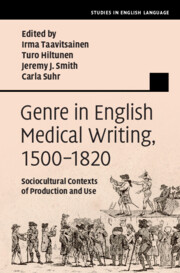Book contents
- Genre in English Medical Writing, 1500–1820
- Studies in English Language
- Genre in English Medical Writing, 1500–1820
- Copyright page
- Contents
- Figures
- Image Gallery
- Tables
- Notes on Contributors
- Preface
- Acknowledgements
- Chapter 1 Medical Discourse and Sociocultural Contexts 1500–1820
- Chapter 2 John Arderne’s Afterlife in Manuscript and Print
- Chapter 3 John Mirfield’s Gouernayl of Helþe
- Chapter 4 Surgical Handbooks Translated into Low German
- Chapter 5 Tracing the Early Modern John of Burgundy
- Chapter 6 The Plague in Southern Italy in 1815–1816
- Chapter 7 On Excitability
- Chapter 8 Systems and Centos
- Chapter 9 Medical Vocabulary in English Romantic Literature
- Chapter 10 Foreign Ingredients in Early and Late Modern English Recipes
- Chapter 11 Walter Bailey’s (1529–1593) Medical Genres
- Chapter 12 London Bills of Mortality of the Seventeenth Century
- Chapter 13 Advertising Proprietary Medicines in Pamphlets
- Chapter 14 Persuasion in Hungarian Medical Recipes
- Chapter 15 Persuasion in Early Modern English Medical Recipes
- Chapter 16 Richard III
- Chapter 17 Images and Paratexts
- Preface to the Image Gallery
- Image Gallery
- Index
- References
Chapter 13 - Advertising Proprietary Medicines in Pamphlets
Published online by Cambridge University Press: 13 October 2022
- Genre in English Medical Writing, 1500–1820
- Studies in English Language
- Genre in English Medical Writing, 1500–1820
- Copyright page
- Contents
- Figures
- Image Gallery
- Tables
- Notes on Contributors
- Preface
- Acknowledgements
- Chapter 1 Medical Discourse and Sociocultural Contexts 1500–1820
- Chapter 2 John Arderne’s Afterlife in Manuscript and Print
- Chapter 3 John Mirfield’s Gouernayl of Helþe
- Chapter 4 Surgical Handbooks Translated into Low German
- Chapter 5 Tracing the Early Modern John of Burgundy
- Chapter 6 The Plague in Southern Italy in 1815–1816
- Chapter 7 On Excitability
- Chapter 8 Systems and Centos
- Chapter 9 Medical Vocabulary in English Romantic Literature
- Chapter 10 Foreign Ingredients in Early and Late Modern English Recipes
- Chapter 11 Walter Bailey’s (1529–1593) Medical Genres
- Chapter 12 London Bills of Mortality of the Seventeenth Century
- Chapter 13 Advertising Proprietary Medicines in Pamphlets
- Chapter 14 Persuasion in Hungarian Medical Recipes
- Chapter 15 Persuasion in Early Modern English Medical Recipes
- Chapter 16 Richard III
- Chapter 17 Images and Paratexts
- Preface to the Image Gallery
- Image Gallery
- Index
- References
Summary
This chapter focuses on the hybrid genre of pamphlet advertisements of proprietary medicines from the late seventeenth century. These texts have a dual purpose: on the one hand, they promote a medical product, and on the other hand, they appropriate and distribute medical information for the general public. A move analysis of thirty-two advertisements reveals seven structural elements, of which three can be considered obligatory elements. Parallels with the structural elements of recipes and specialised medical treatises are also considered to show how established elements are appropriated and mixed from different existing genres alongside completely fresh elements in the new hybrid genre. The analysis thus shows the dynamic nature of medical writing of the period, in which authors made use of their considerable knowledge of established medical genres and the characteristics of the contemporary medical marketplace to form a new genre for new purposes.
Keywords
- Type
- Chapter
- Information
- Genre in English Medical Writing, 1500–1820Sociocultural Contexts of Production and Use, pp. 211 - 230Publisher: Cambridge University PressPrint publication year: 2022



